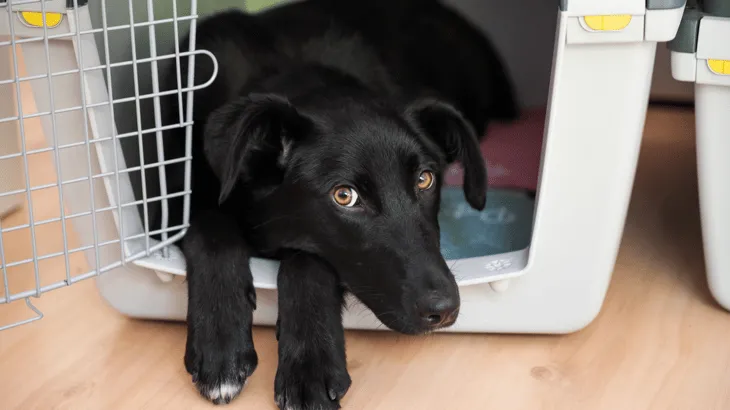Your Ultimate Guide to Choosing the Best Dog Crate for Flying
If you’re planning to travel by plane with your furry friend, finding the right dog crate to use during the flight is essential. As any dog owner knows, flying can be a stressful experience for pups. An appropriately sized, comfortable crate helps provide security and stability in an unfamiliar environment.
Understanding Your Dog’s Needs
From my experience as a vet, the first step is evaluating your dog’s individual personality and needs. Are they prone to anxiety? How do they typically handle new situations? Paying attention to these traits will help you select a crate design best suited to putting them at ease.
I’ve seen dogs who like tight, enclosed spaces feel safer in soft-sided variations. More independent pups may prefer wire crates allowing better visibility. Very energetic dogs benefit from extra room to move around. Make sure any crate leaves enough space for your dog to stand up, turn around, and lie down in a natural position.
Selecting the Right Size
The commonly stated rule of thumb is to choose a crate large enough for your dog to sit comfortably but not much bigger. However, basically it really depends on the individual dog. I’ve found having a few extra inches of space doesn’t tend to cause issues for most, allowing wiggle room as needed.

Keep in mind airlines have strict size limits for carry-on crates, usually around 22″ long by 16″ wide by 11″ tall. Anything bigger requires checking your dog as cargo. Measure your pup and their favorite resting spot at home to ensure the crate you bring fits regulations for the cabin.
Factors to Consider in Your Decision
- Material: Soft-sided or rigid wire/plastic crates? Breathable fabrics or thicker walls?
- Ease of Cleaning: Removable trays, versatile straps, and machine-washable liners are convenient.
- Portability: Collapsibility, lightweight build, and convenient carrying handle are useful features.
- Comfort: Padded padding, plush blankets, chew-proof construction.
- Cost: Affordability while still meeting airline regulations and your dog’s needs.
Some Real-Life Examples
Kind of as an anecdote, here’s how I’ve applied these factors in choosing crates during my own travels with dogs:
For a anxious miniature schnauzer I flew with, I went with a soft-sided Sherpa brand crate since its cozy fabric helped soothe her nerves. Despite being bulky to pack, it had her feeling secure. When flying my rowdy lab-mix, a collapsible MidWest wire crate kept her from chewing the walls while allowing staff easy visibility during check-ins.
The worst experience was an old plastic crate without adequate air flow – my dog got overheated on a long delay. So basically, comfort and ventilation can literally be a life saver on flights lasting hours. That’s why I now prefer crates boasting generous airflow, built-in bowls, and even removable beds for more luxurious travel days.

Tips for a Smooth Trip
Once you select the right crate, here are some additional tips for making flying day as low-stress as possible:
- Take test trips with your dog in their crate at home before flying to help them feel secure and comfortable.
- Provide favorite chew toys, treats or a worn shirt with your scent to comfort them.
- Contact your vet about mild calming aids for anxious flyers if needed.
- Bring copies of important documents like vaccination records in case requested.
- Hand-carry the crate onto the plane if possible or tag it clearly for baggage claim.
With some preparation using tips from an experienced vet like myself, you and your furry family member can feel confident and ready for take off! Don’t be afraid to contact your airline in advance with any other special needs. Safe travels to both you and your pup!
Key Considerations When Choosing a Dog Crate for Flying
| Crate Size | Material | Door Type | Ventilation | Collapsibility |
|---|---|---|---|---|
| Choose a crate that allows your dog to stand up and turn around comfortably but is not too large for the cargo hold or airline requirements. | Plastic or metal for durability, weight and ventilation. Soft-sided are lighter but less sturdy. | Top-loading provides more security versus side-opening. | Mesh panels or multiple ventilation holes keep air circulating. | Collapsible crates pack down small but reassemble easily for travel. |
| Measure your dog and allow 2-4 extra inches in all directions. | Plastic easily cleaned; metal strongest but heaviest. | Secure latches prevent accidental opening during travel. | Avoid fabric-only crates with no ventilation. | Consider weight and portability through airport and to/from car. |
| Airline size guidelines are approximate; staff may measure your crate and dog together. | Fabric covers provide insulation and privacy. | Look for multiple latches or locks for security. | Test crates before travel to ensure comfort and fit. | Collapsible crates pack down but may be less durable. |
FAQ
-
Can my dog fly in a crate?
Most airlines allow dogs to fly in crates basically. But they have size limits for the crate. The crate needs to be big enough for your pup to stand up, turn around, and lie down comfortably. You’ll want to check with the airline for their precise rules.
-
What size crate do I need?
The size crate you need depends on how big your dog is. The minimum crate size allowed on flights is usually about the size of the dog +10%. So for a medium sized dog, expect a crate around 21-24 inches wide by 17-20 inches deep by 17-20 inches tall. Check the airline rules for exact dimensions. Bigger is better if your dog tends to feel anxious.

-
How do I crate train my dog before flying?
Getting your dog accustomed to their crate before a flight is key. You’ll want to start by feeding them in the crate and giving treats whenever they go inside. Later, work up to closing the door for short periods with them inside. Praise and reward calm behavior. Once they seem kinda at ease being crated, try doing it when you’re out of sight too. Practice makes perfect!
-
Won’t the crate be stressful for my dog during the flight?
It’s possible the crate may cause some stress. However, if properly crate trained beforehand, it actually provides security and reduces anxiety compared to being loose in a strange environment. Consider giving your dog a snuggly toy or blanket with your scent too. And don’t forget, the crate keeps them safe from injury during take-offs and landings.
-
Is it better to sedate my dog for the flight?
Sedation is really a choice between you and your vet. Perhaps spend time discussing pros and cons. Sedation can help calm nerves, nevertheless dogs sometimes act peculiar from meds. It may kinda mask problems too. If your dog isn’t a pro at being crated, sedating first trips might help. But maybe not always needed once accustomed. Ask your vet’s advice based on your pup’s personality.
-
What steps should I take for the flight?
Check airline rules in advance, reserve space early, bring food/water as allowed per flight duration, consider diaper for long hauls, provide ID tag on leash and crate, don’t forget vacc records. Have your pup accustom to the crate before flying. And perhaps distract them with toys or you bring a worn piece of clothing for comfort. Best ensure they arrive happy and stress-free!

-
Do I need to worry about my dog during connections?
You bet ports of call meant for humans can be confusing for pups! However, don’t forget cargo handlers are generally quite experience and cares about animal passengers. Most airlines carefully coordinate connecting flights for pets. The same crews often work all legs of trips. So in spite if possible transport delays, handlers try hard getting pets off one aircraft ASAP to board the next. Stay in touch with airlinetoo – they wanna keep furry fliers content!
-
Any other flying tips to reduce stress?
Bring along a stuffed animal that smells like home. You could also consider doggie CBD or natural anti-anxiety supplements from the vet. Make sure your pup goes potty before flying too – minimizes hassles. Oh and a stuffed Kong toy filled with peanut butter could entertain for hours! Stay optimistic, comfort your furry friend, double check everything, and with preparation their trip can hopefully go amazingly smooth.
